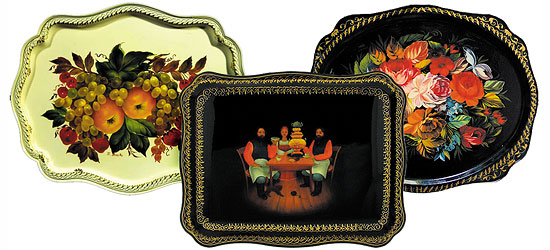ZHOSTOVO TRAYS
Zhostovo painting is an old Russian folk handicraft, one of the most widely known types of Russian folk art.
The art first appeared in the early 19th century in the village of Zhostovo. The village is located in picturesque area near Moscow. The handicraft of painting flowers on iron trays made Zhostovo famous not only in Russia but far beyond. The expertise of local craftsmen was truly unrivaled.
As tea became more and more famous in the 19th century Russia, it gradually replaced the traditional Russian drinks, such as sbiten, mead, and various herbal teas. A tea-drinking culture was soon formed. Tula craftsmen began making samovars, which were usually served on trays. Trays became an indispensible element of traditional Russian tea parties.
Zhostovo painting is used on metal trays made of thin roof steel. After stamping, the sheets of steel are primed, polished and covered with several layers of oil-based lacquer, usually of black color. The trays are then hand-painted. The patterns are applied in several consecutive stages. The artist uses a soft brush and oil paints with generously added linseed oil, which produces thick, broad, energetic and dynamic (“extended”) strokes. Most Zhostovo patterns are floral, simple and laconic in shape. Usually the artist would paint large and lush garden flowers and small wild flowers surrounded with fresh leaves. The flowers look real and three-dimensional, and the color palette is decoratively bright. The patterns are similar to Russian folk painting on chests, spinning wheels, and birch-bark baskets. The well known bluebells, chamomiles and cornflowers look different when painted in this technique. The edges of the tray are often decorated with thin gold-colored ornaments (uborka). The completed painting is covered with three layers of light lacquer and polished to a mirror-like shine.
Ural floral themes used for painting metal surfaces greatly influenced the Zhostovo technique. Its further development was later affected by Moscow regional porcelain and enamel-painting techniques, patterns used on cotton prints in Ivanovo, and Lukutin miniatures.
In the late 19th and early 20th centuries Zhostovo business declined. In 1928 several workshops were merged into one single factory thus creating an impetus for development of this remarkable folk craft.

